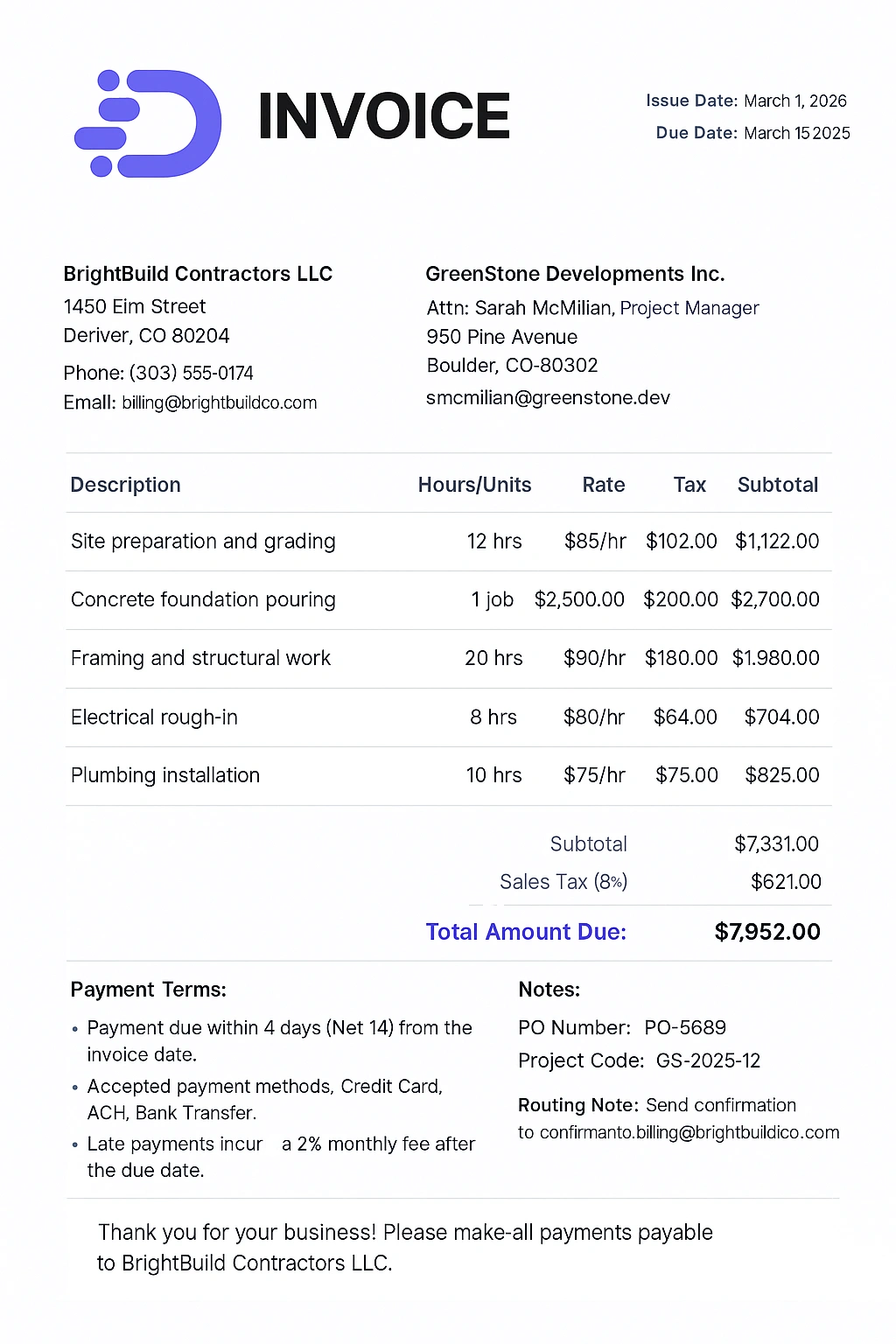A contractor billing invoice is a professional document that outlines the services provided, project milestones, labor, materials, and agreed-upon rates. Contractors use it to ensure transparency with clients, track payments, and maintain accurate financial records.
Unlike standard invoices, a contractor billing invoice often includes detailed descriptions of work completed, payment terms, and deadlines, helping both parties avoid misunderstandings and streamline the payment process. Properly prepared invoices not only speed up collections but also enhance a contractor’s credibility and financial organization.
A well-written payment request records the work you did and what the client owes. It serves as an official record for both sides and reduces confusion about services, rates, and due dates, especially important as 71% of subcontractors report delayed payments from general contractors, with average payment cycles stretching to 57 days.
Clear documentation prevents disputes, aids bookkeeping, and speeds up payment. Good statements also support accounting and tax reporting, making reconciliation with payment records easier during tax time.
Consistent, professional forms help client accounts teams process payments faster. Tools like DepositFix support clear delivery, digital access, and easy online payment to improve cash flow.
Clear, consistent documentation makes payment faster and reduces disputes. The top of your page should show a bold "Invoice" label, a unique invoice number, and the issue date so the record stands out in a busy inbox.
List your business name, address, phone, and email. Add the client's billing contact and address so the document reaches the right approver.
Break out each service with a short description, hours or units, rate, tax, and a line subtotal. Show the combined total amount clearly and state the specific payment due as a full calendar date (for example: March 15, 2025).
State concise payment terms, accepted payment methods, and any late-fee policy. Add project codes, PO numbers, or routing notes to speed approvals.

Start with a clean, branded template so approvers instantly recognize your work. Use your logo, consistent fonts, and clear headings to improve readability and speed approval.
Use a standard layout that shows company contact info, client contact, and an obvious Invoice label. Consistent styling helps accounts teams find what they need.
Give each document a sequential number and include the issue date. This anchors due dates and creates an audit trail for accounting and record keeping.
Break the project into tasks or milestones that mirror your contract. List hours, units, or deliverables so the client can match charges to approved work.
Enter quantities and rates, compute taxes, apply agreed discounts, and verify totals. Position the final amount prominently so approvers validate it at a glance.
Precise payment dates and simple options cut delays and protect your cash flow. State a full due date (for example: Payment Due March 24, 2025) rather than vague phrasing. Clear dates remove confusion and speed approvals.
Use a specific calendar date and add a concise late-fee policy to motivate timely payment. Example: "1.5% monthly late fee after Payment Due March 24, 2025." Keep the policy fair and easy to understand.
List common digital payment options and accept multiple channels to lower barriers. Offer ACH, card, and pay-by-link so clients can settle quickly.
Send each payment request right after a job finishes so approval and payment follow quickly. Use a standout subject line that includes the number, service, and due date. Example: Invoice #102 for Roof Installation — Due March 24, 2025.
Keep the email brief. Summarize what the document covers, state the exact due date, and list easy payment options. Attach the document and add a short call to action so approvers know the next step.
Send invoices immediately at project completion or per milestone to align billing with delivery. Configure automated reminders for upcoming, due, and overdue states to nudge payment without manual effort.
After the due date, follow up with polite escalation. Offer clear next steps and a deadline for response. Track views, status, and payments in DepositFix so you always know which items need attention and protect cash flow.
Missing or wrong information often turns a fast payment into a long chase.
Small errors create preventable delays. Accurate forms help approvals move faster and keep your accounting tidy.
Don’t send documents without a clear number, issue date, or payment due date. Those basics speed validation.
Verify recipient contacts so your file reaches the right person or department instead of stalling in a shared inbox.
State concise terms and any late fees so the client knows expectations and you avoid back-and-forth.
Poor layout and absent supporting papers cause rejections. Attach required purchase orders or change authorizations to prevent hold-ups.
Tip: Use DepositFix templates and checklists to eliminate these mistakes, protect cash flow, and keep year-end tax and accounting work simpler.
DepositFix gives you a single software hub to standardize documents, automate delivery, and speed collections for your services and projects.
Use consistent templates so branding, line items, and payment terms stay the same on every invoice you send. Automate unique numbering to preserve an audit trail and simplify accounting reconciliations.
Send invoices digitally with embedded payment links and support common payment methods so clients pay faster. Schedule automated reminders and dunning sequences to cut manual follow-up and improve cash flow.
A well-crafted contractor billing invoice provides smooth, timely payments and professional client relationships. With clear service details, accurate totals, precise payment terms, and consistent formatting, contractors reduce disputes and accelerate cash flow.
Tools like DepositFix simplify invoicing, automate reminders, and provide secure, trackable payment options, all while maintaining a clean audit trail. Following these best practices not only ensures you get paid faster but also reinforces your credibility, keeps accounting accurate, and frees up time to focus on delivering exceptional work.
Discover the hidden automation in your payment, billing and invoicing workflows. Talk to our experts for a free assement!
